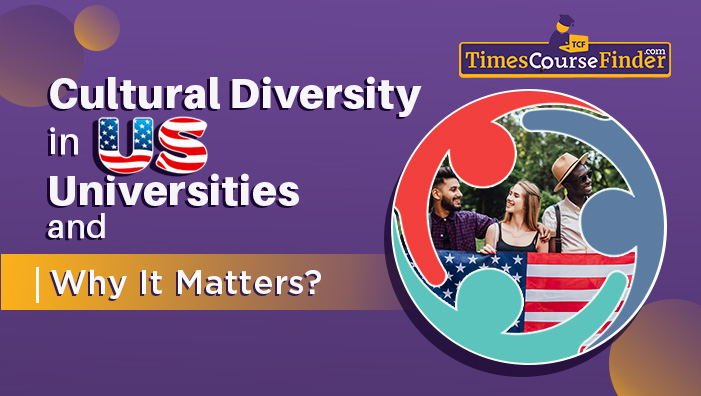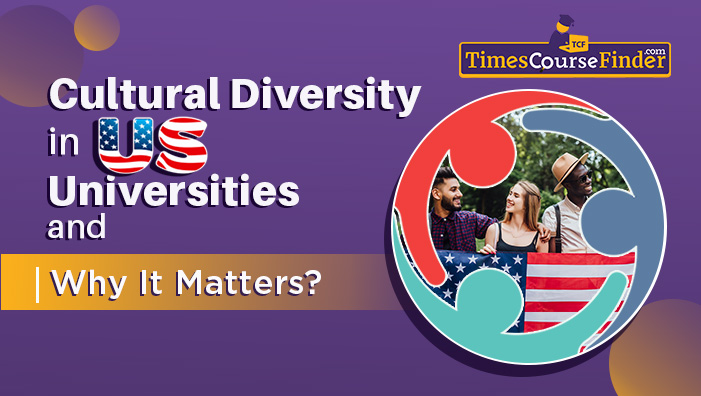
Cultural Diversity in US Universities
U.S. universities host students from over 190 countries, creating multicultural campuses that enhance learning, inclusion, and global career opportunities. Learn why cultural diversity is a strength of American education.
 TCF SEO
TCF SEO

With students from more than 190 countries enrolled each year, the United States is home to some of the most multicultural campuses in the world. The presence of varied backgrounds, languages, and perspectives shapes the learning environment in ways that go far beyond academics.
This blog explores the importance of cultural diversity in American universities, the experience it offers, and how it contributes to student success both during and after your degree.
Table of Content
What Cultural Diversity Looks Like in US Universities
A Diverse Learning Environment Benefits Everyone
International Student Culture in the USA
Multicultural Campuses Encourage Inclusion
Support Services that Make the Difference
Building Global Networks Through Diversity
A Foundation for Global Careers
1. What Cultural Diversity Looks Like in US Universities
Cultural diversity in American universities means more than just international enrollment. U.S. campuses welcome people of different ethnicities, religions, nationalities, and socio-economic backgrounds. Classrooms are often a mix of local and international students who bring unique views, traditions, and life experiences to discussions.
This environment encourages open dialogue, understanding of global issues, and respect for different skills that are critical in today’s interconnected world.
Learn more about what makes the U.S. a preferred destination: Why Study in USA
2. A Diverse Learning Environment Benefits Everyone
The benefits of diversity in education are backed by years of research and student experience. When students are exposed to different cultures and worldviews, they develop:
- Broader thinking and critical analysis
- Better collaboration skills in multicultural teams
- Greater cultural sensitivity, sound judgment in any career path
- Stronger problem-solving abilities through exposure to different perspectives
These benefits are not limited to international students. Domestic students also gain valuable insight by learning and growing alongside peers from across the world.
3. International Student Culture in the USA
The U.S. is home to nearly 1 million international students, and their presence shapes university life across campuses. Institutions often have active student-led organizations representing countries and regions, hosting festivals, food fairs, language exchange programs, and dialogue events.
This lively international student culture USA offers a chance to feel connected while being far from home. Whether it’s Diwali on campus, a Lunar New Year celebration, or Iftar dinners during Ramadan, students are encouraged to share and celebrate their heritage.
Discover more on campus activities and student engagement: Student Life & Cultural Experience.
4. Multicultural Campuses Encourage Inclusion
Many U.S. universities have built intentional policies around inclusion, equity, and respect. This includes multicultural student centers, gender support groups, international clubs, and diversity-focused scholarships. The idea is to ensure that everyone, regardless of where they come from, has a voice and feels seen.
Multicultural campuses USA are also safer and more welcoming thanks to support staff trained in cultural sensitivity and anti-discrimination practices.
In classrooms, professors often structure discussions to include global viewpoints, and many courses incorporate international case studies and cross-cultural topics.
5. Support Services that Make the Difference
Studying abroad comes with adjustment challenges, social, emotional, and academic. But U.S. institutions have well-developed student support services USA that address these concerns head-on. For international students in particular, the following resources are typically available:
- International student offices offering visa guidance and academic advising
- Mental health support tailored to cross-cultural stress
- Language assistance and writing centers
- Career development tailored to international job markets
- Peer mentoring programs
These services are a critical part of what makes U.S. education effective and supportive for students from all corners of the world.
Don’t forget to review how universities help with health and well-being: Healthcare and Insurance
6. Building Global Networks Through Diversity
One of the lasting effects of diverse student life USA is the connections you build. Your classmates might be future policy makers, business leaders, or scientists across the world. These connections become part of your global professional network.
It’s not uncommon for students to meet future business partners, research collaborators, or lifelong friends through student groups and academic projects on U.S. campuses.
7. A Foundation for Global Careers
Employers worldwide value candidates who are adaptable and culturally aware. If you’ve studied in a diverse environment, you’ve already developed the skills needed to work with teams across borders.
Having a U.S. degree signals not only academic readiness but also the ability to thrive in multicultural settings. These soft skills, communication, empathy, and open-mindedness, are in high demand across industries from business and healthcare to tech and government.
Conclusion
Cultural diversity in American universities is not just a feature; it’s a core strength. It enriches the academic experience, supports emotional well-being, and prepares students to succeed in international careers. The combination of a strong educational foundation and exposure to global perspectives helps students grow into professionals who can lead and collaborate anywhere in the world.
If you’re ready to study in a place where your culture is respected and your views are valued, U.S. universities offer precisely that. For personalized advice on choosing the right program or understanding student support in the U.S., speak with our advisors here.
FAQs
- Which university is the most diverse in the US?
Several U.S. universities, such as New York University (NYU), University of Southern California (USC), and Rutgers University, are often ranked among the most diverse due to their high international student enrollment and multicultural campuses.
- What is an example of cultural diversity in the United States?
An example is the presence of students from more than 190 countries on U.S. campuses, celebrating traditions like Diwali, Lunar New Year, and Ramadan together.
- How diverse are colleges in the US?
Most U.S. colleges host a mix of local and international students from varied ethnic, religious, and socio-economic backgrounds, creating truly multicultural classrooms.
- What are the benefits of cultural diversity in university?
Cultural diversity improves critical thinking, collaboration, cultural sensitivity, and problem-solving skills—all essential for global careers.




